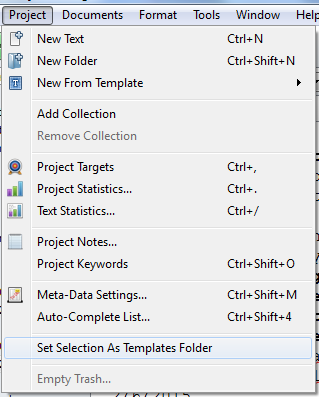Scrivener Tips Pt. 7: Elements For Your Document Template
A few weeks ago, I shared about using the document template feature of Scrivener. It allows you to create a template internal to your project with differing features and content so you can start writing more quickly without forgetting your commonly used elements for your documents. It makes the process of writing approachable.
But what should you include in a document template? How much should you include? What’s the benefit of this bit of work? Let’s take the last two questions first.
As to how much you should put into a document template, this depends on your needs. If you need a simple template with all the common formatting for your project then it’s a straightforward process. If the nature of your project requires more information then you should include that. For instance, with a blog or newsletter project (assuming you are using a year-long project for these), you can use the document template to include common content that appears in all your posts or newsletters.
As to the benefits, it’s a time-saver. You won’t waste time re-creating the same document conditions every time you start a new chapter, blog, newsletter, etc. Also, this template usage eliminates forgetting to include common content such as those used on blog posts and newsletters.
But what should you include in your Scrivener document template? Here are a some suggestions:
 1. You may want to create several templates depending on what your project is. As an example, I’m using a year-long project for my blog posts and newsletters so I may need multiple templates for these. This is especially true of my blog project where I develop different kinds of posts. I can make different templates for Scrivener posts, interview posts, serial posts and general category posts.
1. You may want to create several templates depending on what your project is. As an example, I’m using a year-long project for my blog posts and newsletters so I may need multiple templates for these. This is especially true of my blog project where I develop different kinds of posts. I can make different templates for Scrivener posts, interview posts, serial posts and general category posts.
2. Include your ending content for blog posts. Again, these may differ based on the type of post.
3. Include introductory content. Again this may differ depending on usage but it sure helps you jump into writing without much worry with getting everything correct.
4. Regarding formatting, do you have special formatting that will be used in your project several times? Then you should consider creating a template that incorporates this formatting. There’s nothing so time consuming than trying to re-create formatting to match earlier content. With the document template you can re-create that formatting by choosing to use the template.
The main take-away is to include as much as necessary to simplify your writing process rather than get bogged down with unnecessary details. As I run across a repetition of form in projects I’m creating a new document template or adding necessities to existing ones. That way I will spend less time on continuity and complete my writing faster.
 How can you use document templates in your Scrivener projects to streamline your writing? If you’re already using this feature, what elements of your writing do you include in your document templates? Please share your thoughts and ideas in the comments section. I’d also love to connect with you over social media so check my Contact page for that information. See the News page for announcements and remember to sign-up to receive news and posts by email. I’ve added a new sign-up tab on my FaceBook page to simplify the process. New followers can download The Black Bag via free coupon today! Also, the cover of my book, The Bow of Destiny, was revealed recently so take a look.
How can you use document templates in your Scrivener projects to streamline your writing? If you’re already using this feature, what elements of your writing do you include in your document templates? Please share your thoughts and ideas in the comments section. I’d also love to connect with you over social media so check my Contact page for that information. See the News page for announcements and remember to sign-up to receive news and posts by email. I’ve added a new sign-up tab on my FaceBook page to simplify the process. New followers can download The Black Bag via free coupon today! Also, the cover of my book, The Bow of Destiny, was revealed recently so take a look.
Follow Blog via Email
Enter your email address to follow this blog and receive notifications of new posts by email.
Screenshots from my blog project
Just as a note: I am not affliated with Scrivener in any official capacity. For support questions, pricing and other concerns please contact the vendor.
Filed under: Blogging, Cover Reveal, Creativity, Editing, Fiction, Indie Publishing, Planning, Scrivener, Self-publishing, Social Media, Tech Tips, Templates, The Black Bag, The Bow of Destiny, Tips, Twitter, Writing Tagged: blogging, Coverart, creativity, Editing, Facebook, Formatting, Indie Publishing, P. H. Solomon, Planning, Scrivener, Social Media, The Black Bag, The Bow of Destiny, Twitter, writing






